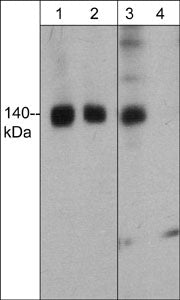Anti-FHOD1 Antibody
- SPECIFICATION
- CITATIONS
- PROTOCOLS
- BACKGROUND

Application
| WB |
|---|---|
| Primary Accession | Q9Y613 |
| Host | Mouse |
| Clonality | Mouse Monoclonal |
| Isotype | IgG1 |
| Clone Names | M352 |
| Calculated MW | 126551 Da |
| Gene ID | 29109 |
|---|---|
| Other Names | FHOS, formin |
| Target/Specificity | Formins include several families of proteins that regulate actin cytoskeletal dynamics via two conserved formin homology domains, FH1 and FH2. The FH1 region contains poly-proline stretches that promote interactions with profilin. The FH2 domain, located C-terminally to the FH1 domain, is highly conserved in formin proteins and possesses actin nucleation and polymerization activities. Through cooperation of FH1 and FH2, formins construct actin-based structures comprising linear, unbranched filaments that are used in stress fibers, actin cables, microspikes, and contractile rings. Several mammalian formins, including mDia1, FRL, and formin homology domain protein 1 (FHOD1) are inhibited through an intramolecular interaction between the C-terminal Dia autoregulatory domain (DAD) and its recognition region at the N-terminus. In FHOD1, this autoinhibitory interaction is disrupted through phosphorylation of Ser-1131, Ser-1137, and Thr-1141 by ROCK. Subsequent FHOD1 activation leads to stress fiber formation. In endothelial cells, thrombin activates this ROCK pathway, leading to FHOD1-mediated stress fiber formation. |
| Dilution | WB~~1:1000 |
| Storage | Maintain refrigerated at 2-8°C for up to 6 months. For long term storage store at -20°C in small aliquots to prevent freeze-thaw cycles. |
| Precautions | Anti-FHOD1 Antibody is for research use only and not for use in diagnostic or therapeutic procedures. |
| Shipping | Blue Ice |

Thousands of laboratories across the world have published research that depended on the performance of antibodies from Abcepta to advance their research. Check out links to articles that cite our products in major peer-reviewed journals, organized by research category.
info@abcepta.com, and receive a free "I Love Antibodies" mug.
Provided below are standard protocols that you may find useful for product applications.
Background
Formins include several families of proteins that regulate actin cytoskeletal dynamics via two conserved formin homology domains, FH1 and FH2. The FH1 region contains poly-proline stretches that promote interactions with profilin. The FH2 domain, located C-terminally to the FH1 domain, is highly conserved in formin proteins and possesses actin nucleation and polymerization activities. Through cooperation of FH1 and FH2, formins construct actin-based structures comprising linear, unbranched filaments that are used in stress fibers, actin cables, microspikes, and contractile rings. Several mammalian formins, including mDia1, FRL, and formin homology domain protein 1 (FHOD1) are inhibited through an intramolecular interaction between the C-terminal Dia autoregulatory domain (DAD) and its recognition region at the N-terminus. In FHOD1, this autoinhibitory interaction is disrupted through phosphorylation of Ser-1131, Ser-1137, and Thr-1141 by ROCK. Subsequent FHOD1 activation leads to stress fiber formation. In endothelial cells, thrombin activates this ROCK pathway, leading to FHOD1-mediated stress fiber formation.
If you have used an Abcepta product and would like to share how it has performed, please click on the "Submit Review" button and provide the requested information. Our staff will examine and post your review and contact you if needed.
If you have any additional inquiries please email technical services at tech@abcepta.com.













 Foundational characteristics of cancer include proliferation, angiogenesis, migration, evasion of apoptosis, and cellular immortality. Find key markers for these cellular processes and antibodies to detect them.
Foundational characteristics of cancer include proliferation, angiogenesis, migration, evasion of apoptosis, and cellular immortality. Find key markers for these cellular processes and antibodies to detect them. The SUMOplot™ Analysis Program predicts and scores sumoylation sites in your protein. SUMOylation is a post-translational modification involved in various cellular processes, such as nuclear-cytosolic transport, transcriptional regulation, apoptosis, protein stability, response to stress, and progression through the cell cycle.
The SUMOplot™ Analysis Program predicts and scores sumoylation sites in your protein. SUMOylation is a post-translational modification involved in various cellular processes, such as nuclear-cytosolic transport, transcriptional regulation, apoptosis, protein stability, response to stress, and progression through the cell cycle. The Autophagy Receptor Motif Plotter predicts and scores autophagy receptor binding sites in your protein. Identifying proteins connected to this pathway is critical to understanding the role of autophagy in physiological as well as pathological processes such as development, differentiation, neurodegenerative diseases, stress, infection, and cancer.
The Autophagy Receptor Motif Plotter predicts and scores autophagy receptor binding sites in your protein. Identifying proteins connected to this pathway is critical to understanding the role of autophagy in physiological as well as pathological processes such as development, differentiation, neurodegenerative diseases, stress, infection, and cancer.


